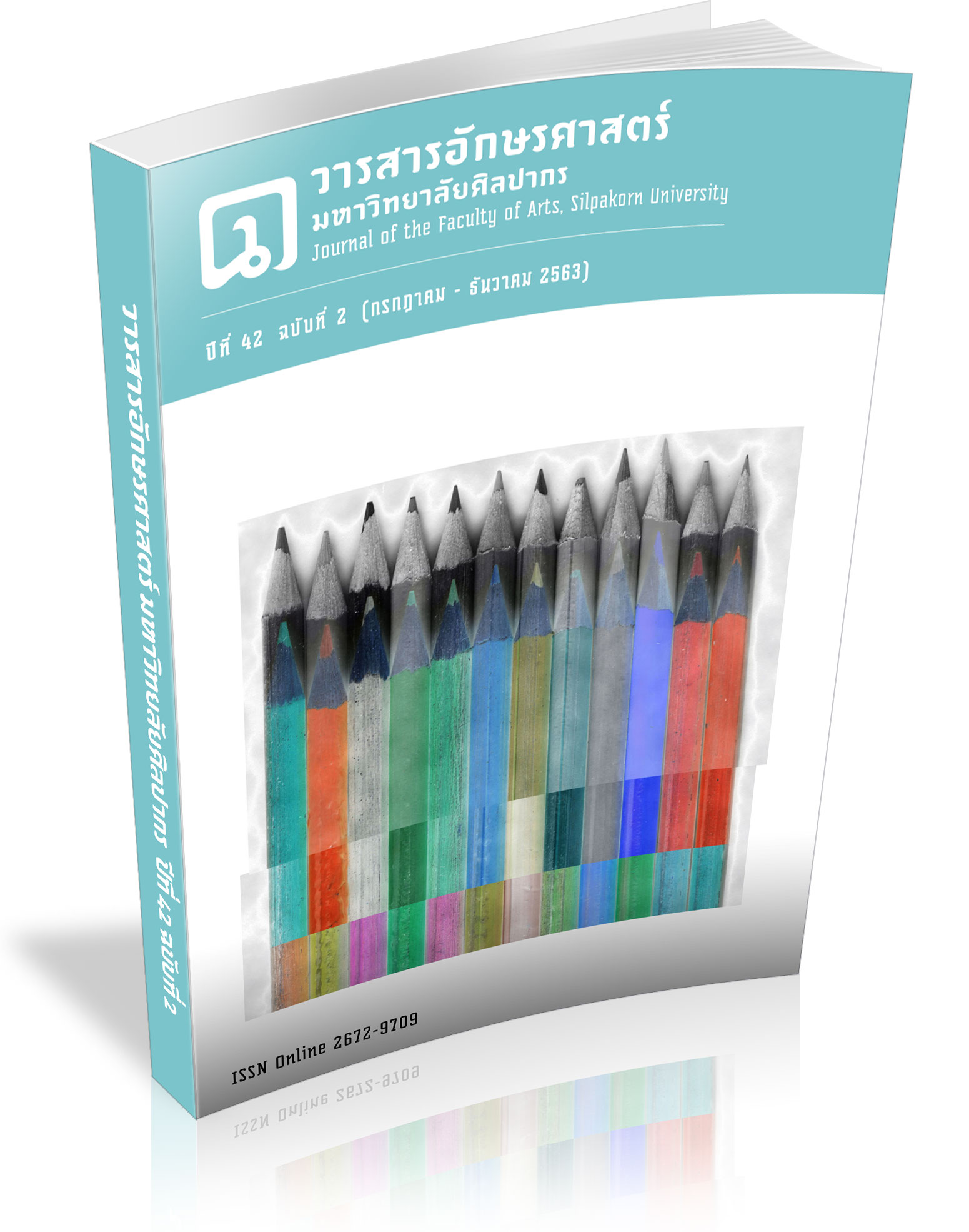ผลการเรียนรู้คำช่วยชี้สถานที่ (に、で、を) และการนำไปประยุกต์ใช้ของผู้เรียนภาษาญี่ปุ่นผ่านกระบวนการเรียนการสอนแบบทางตรง
คำสำคัญ:
คำช่วยชี้สถานที่に, でและを, กระบวนการเรียนการสอนแบบทางตรง, ด้านพุทธิพิสัยบทคัดย่อ
บทความนี้มีจุดมุ่งหมายคือ 1) เพื่อศึกษาสัมฤทธิ์ผลความเข้าใจเรื่องคำช่วยชี้สถานที่ของนักศึกษาชั้นปีที่ 2 คณะอักษรศาสตร์ มหาวิทยาลัยศิลปากรที่ผ่านกระบวนการเรียนการสอนแบบทางตรงในรายวิชาภาษาญี่ปุ่นเบื้องต้น 1-4 โดยอาศัยมุมมองเรื่องการวัดผลการบรรลุจุดมุ่งหมายทางการศึกษาด้านพุทธิพิสัย (Cognitive domain) ตามทฤษฎีของบลูม (Bloom’s Taxonomy) 2) เพื่อศึกษาความแตกต่างของกระบวนการคิดในการเลือกใช้คำช่วยชี้สถานที่ในระดับความจำ ระดับความเข้าใจ และระดับการประยุกต์ใช้โดยใช้เครื่องมือทดสอบทางสถิติ 3) เพื่อหาแนวทางพัฒนาการเรียนการสอนในรายวิชาภาษาญี่ปุ่นเบื้องต้นให้เหมาะสมยิ่งขึ้น ผลการวิจัยพบว่า 1) กระบวนการเรียนการสอนแบบทางตรงในรายวิชาภาษาญี่ปุ่นเบื้องต้น 1-4 ค่อนข้างสัมฤทธิ์ผลในการสอนคำช่วยชี้สถานที่ที่ใช้ความจำอย่างเห็นได้ชัด 2) จากการวิเคราะห์ค่าเฉลี่ยในการเลือกตอบเหตุผลด้วยการทดสอบ F-test วิเคราะห์ความแปรปรวนแบบ ANOVA พบว่า ค่าเฉลี่ยในการเลือกตอบเหตุผลของแต่ละระดับแตกต่างกันอย่างมีนัยสำคัญทางสถิติที่ระดับ 0.05 3) ผลงานวิจัยนี้ทำให้เห็นถึงกระบวนการคิดในการเลือกใช้คำช่วยรวมถึงข้อผิดพลาดในการเลือกใช้คำช่วยชี้สถานที่ของนักศึกษา ซึ่งเป็นแนวทางพัฒนาการเรียนการสอนในรายวิชาภาษาญี่ปุ่นเบื้องต้น 1-4 ให้เหมาะสมยิ่งขึ้น
Downloads
References
Bloom, B., Englehart, M. Furst, E., Hill, W., & Krathwohl, D. (1956). Taxonomy of educational objectives: The classification of educational goals. Handbook I: Cognitive domain. New York, Toronto: Longmans, Green.
Chanchay, S., Thongkamkaew, A. & Naphatthalung, N. (2014). Ability in Reading Comprehension and Written Communication of the First Grade Students by Using Direct Instruction with Graphic Organizers. Journal of Education, Prince of Songkla University, 25 (1), 72-81.
Chawengkitwanich, S. (2013). On The Use of Japanese Praticles Showing Location ‘ni’ and ‘de’ of Thai Learners. Japanese Studies Journal, 30 (2), 75-93. (In Thai)
Jongsutjarittam, P. (2006). A Study on the Error Rate of Particles of University Entrance Examination. The Japan Foundation Bangkok Japanese Culture Center Bulletin of Japanese Education, (3), 53-64. (In Thai)
Joyce, B., & Marcha, Wl. (1996). Model of Teaching. 4TH ed. Englewood Cliffs, NJ : Prentice-Hall.
Kamimura, F. (2003). On L2 Learners’Acquisition of Japanese Particle “ni”. Ariake : Kumamoto University linguistic papers, 2, 151-170. (In Japanese)
Khammani, T. (2017). Science of teaching Pedagogy: Knowledge in order to provide an effective learning process. 21st ed. Bangkok: Chulalongkorn University Press. (In Thai)
Na ranong, S. (2003). Study on grammatical errors in elementary and intermediate Japanese composition writing of Thai students: Problems in using particles. Proceedings of 41th Kasetsart University Annual Conference: Education, Social Sciences, Economics, Business Administration, Home Economics, Humanities, pp.448-455, Bangkok, Kasetsart University. (In Thai)
Okada, M., & Hayashida, M. (2016). Acquistition of the Goal Particle ni and the Active Particle de by Intermediate Level Chinese-Speaking Japanese Learners. Nihongokyouiku, (163), 48-63. (In Japanese)
Pradubwate, R. (2017). Technology Learning Management Guidelines by using Bloom's taxonomy. Veridian E-Journal, Silpakorn University (Humanities, Social Sciences and Arts, 10 (3), 1051-1065.
Promratana, P.L. (2015). Developing Question-Asking Skills Based on the Concept of Bloom’s Taxonomy for Designing Achievement Test. Retrieved 1 May 2020, from http ://www.educathai.com/upload/content/file_1447182498.pdf. (In Thai)
Sakoda, K. (2001). A Language Processing Strategy that Produces Learners' Errors : The Case of 'NI' and 'DE' Showing Location. Bulletin of the Department of Teaching Japanese as a Second Language, Hiroshima University, (11), 17-22. (In Japanese)
Shimada, K. (2011). Analysis of misuse of learners of Japanese-A case study of native Chinese speakers. Yamaguchi Kokubun, (34), 96-106. (In Japanese)
Yamaguchi, K. (2017). On the characteristics of sentences in which overuse of "ni" appeared in the composition of beginner learners, Academia. Literature and language, (101), 169-184. (In Japanese)
Downloads
เผยแพร่แล้ว
How to Cite
ฉบับ
บท
License
ผู้เขียนบทความต้องยินยอมในข้อกำหนดต่าง ๆ ของวารสารก่อนส่งบทความตีพิมพ์



